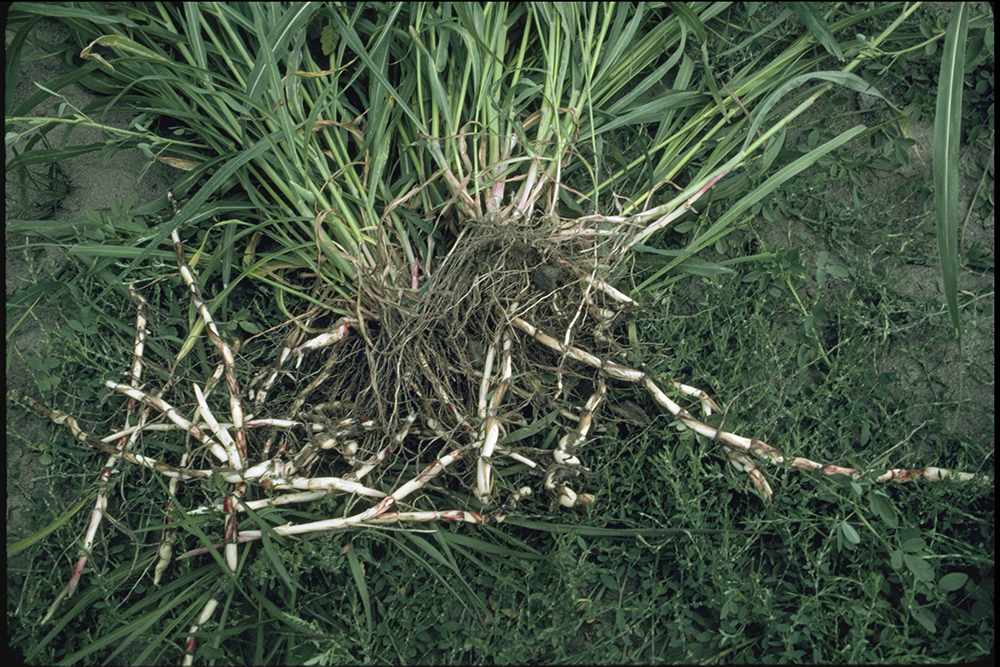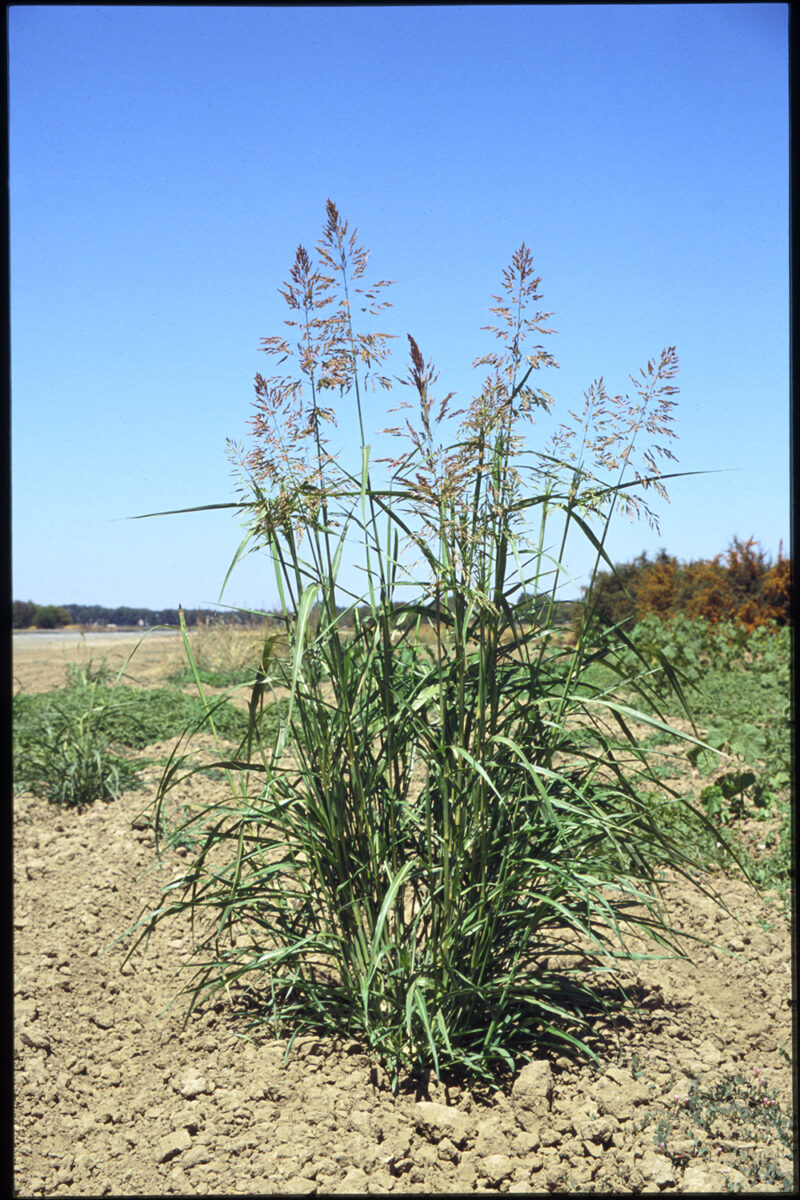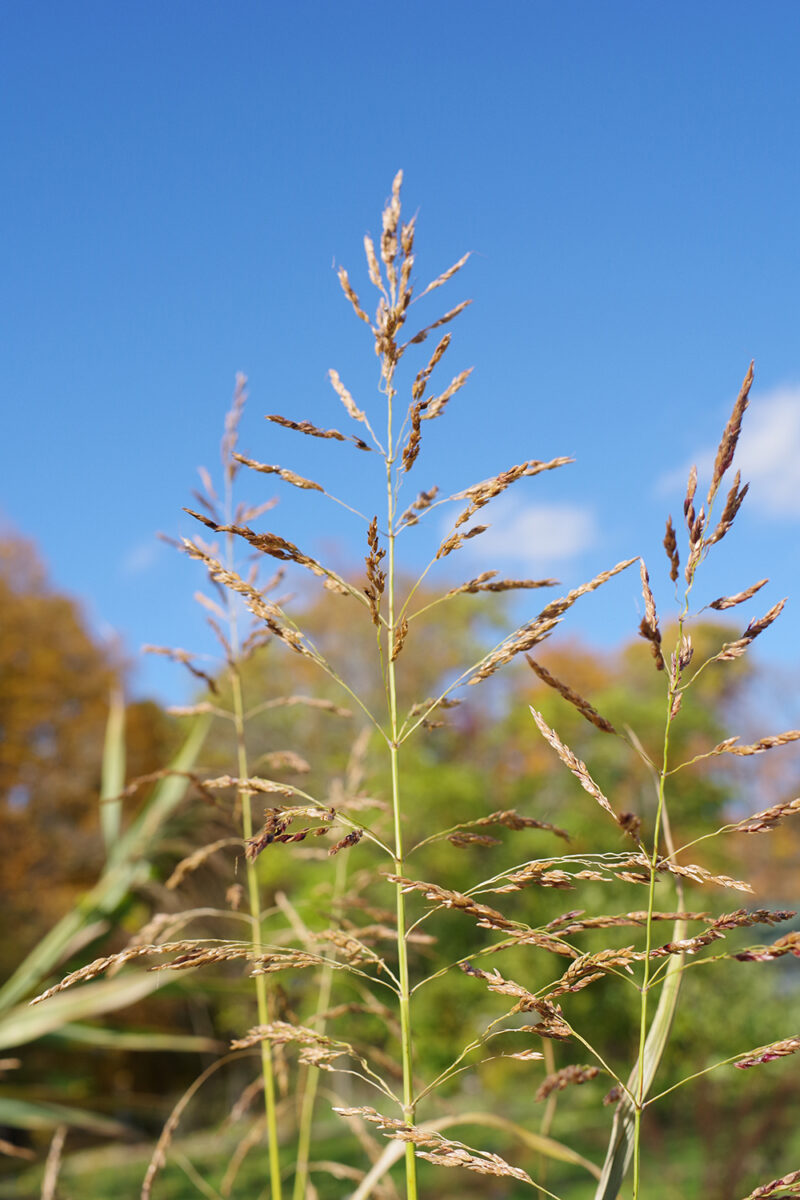Other common names: Johnson grass, Egyptian millet, means grass, Egyptian grass, false guinea grass, millet grass, Morocco millet, Aleppo grass, grass sorghum, Cuba grass, St. Mary’s grass, evergreen millet, maiden cane, Arabian millet, false guinea, Syrian grass



Sorghum halepense (L.) Pers.
Identification of Johnsongrass
Family: Grass family, Poaceae
Habit: Perennial grass spreading by thick rhizomes
Description: The seedling leaf is roughly horizontal and 0.6–1 inch long by 0.16–0.24 inch wide. The collar region of true leaves is narrow, pale and absent of auricles. The membranous ligule is translucent with fine teeth. Seedling true leaf blades are 1.6–7 inches long by 0.1–0.2 inch wide, hairless and rolled in the bud. The midrib is strong and white near the base of the blade. Sheaths are green, hairless, smooth, open and sometimes red at the base. Seedlings closely resemble domestic corn or sorghum. Mature plants produce tillers that grow 2–8 feet tall. Stems are pale yellow-green and 0.8 inch in diameter at maturity. Sheaths are flattened, hairy, open, ribbed and slightly toothed; sheaths are maroon to red-brown at the base and pale green near the collar region. The collar region is broad, smooth and pale, with a translucent 0.2 inch-long membranous ligule on newer leaves and a fringed, hairy ligule on older leaves. Some scattered hairs are present above the collar on the upper surface of rough edged blades. Blades are lanceolate (8–24 inches long by 0.2–2 inches wide, but typically less than 1 inch) wide, with a strong, wide, white midrib. Roots are fibrous and grow from an aggressive rhizome system that can exceed 6 feet; rhizomes are white with purple or red splotches and long, scaly, brown sheaths at nodes. The inflorescence is a purplish, 6–20 inch-long panicle. Several branches, reaching up to 10 inches long, are widely spaced and whorled about the nodes. Branches are further divided into spikelets attached in pairs along the length of the subdivision. Each spikelet pair has a longer, sterile flower with no awn and a shorter, broader, fertile flower with a twisted and kinked awn. Fertile flowers produce one 0.1 inch-long, oval shaped, dark chestnut brown seed. As with other grasses, a thin, dry layer of fruit tissue adheres tightly to the seed coat.
Similar species: Young plants may be confused with fall panicum (Panicum dichotomiflorum Michx.). However, johnsongrass does not have a hairy ligule or dense hairs on leaf undersides, sheaths or collars. Shattercane (Sorghum bicolor (L.) Moench ssp. verticilliflorum (Steud.) de Wet ex Wiersema & J. Dahlb.) is closely related and seedlings differ from johnsongrass only by their half membranous, half hairy ligule and the presence of hairs on both blade surfaces near the collar. Mature shattercane lacks rhizomes, has purple spotted stems and can reach 13 feet high.
Management of Johnsongrass
Johnsongrass is considered one of the world's 10 worst weeds because it is widely distributed and difficult to control. No-till systems tend to favor the establishment and growth of johnsongrass populations. Conversely, repeated tillage to break up and exhaust rhizomes dramatically limits the growth of this weed and is the most common method of non-chemical control. The rhizome buds will sprout any time the soil is warm, so tillage is effective during late spring, summer and early fall. Tillage during cool weather in early spring or late fall is useless since it will not prompt the buds to sprout. Before you begin an eradication attempt, determine how deep the rhizomes go in your soil by digging a few test pits. Deep, rotary tillage with slow forward motion will chop the bulk of the rhizomes into very small pieces that are easier to exhaust. For treating large areas, heavy disks are probably the best implement. If you have many deep rhizomes, follow this with deep chisel plowing. Two passes at a 90-degree angle to each other will work best. Do the rotary tillage or disking first, since otherwise the chisel plowing will loosen the rhizomes and prevent them from getting cut into small pieces. Carbohydrate storage in the rhizomes reaches a minimum 10–30 days after the shoots emerge and when plants are 6–12 inches high with 4–8 leaves, so successive tillage events at this time will eliminate shoots before the rhizomes recharge. A field cultivator is ideal for suppressing regrowth after the initial attack on the rhizome system.
Johnsongrass populations can also be badly damaged by overheating or freezing the rhizomes. Naturally, the former works better in subtropical portions and the latter works better in temperate portions of this weed’s range. For either procedure, use tillage that breaks the rhizome into coarse fragments and work the pieces to the soil surface with a spring tooth harrow. To freeze kill the rhizomes, the frost must penetrate into the soil. If you are treating a small area, push snow off to ensure deep frost penetration. When the soil freezes to a crust, chisel plow to break up the surface and allow deeper penetration of the frost and thorough freezing of the surface chunks. Freeze killing johnsongrass depends entirely on your coldest snow free winter weather conditions. The procedure may fail completely one year but work well the next.
Heat killing works best on dark colored soils. Do this during the hottest, sunniest part of the summer. Direct sunshine is more critical than high air temperatures for heating the soil. After the rhizomes have cooked for a few days (see “Drought tolerance”), stir the soil with a field cultivator or spring tooth harrow to bring new rhizomes to the surface. Remember that summer soil temperatures drop rapidly with depth. Small areas can be treated more effectively by covering the soil with black or clear plastic. Remove the plastic periodically so you can stir the soil to expose more rhizomes to killing temperatures.
Persistence is the key to johnsongrass management. Once you have set the population back to manageable levels with the procedures above, continue to hammer it whenever a break in your cropping allows a clean tilled fallow period or heat killing.
Ecology of Johnsongrass
Origin and distribution: Johnsongrass is native from southern Europe through India. It was introduced into the southeastern United States in the early 1800s as a forage crop and subsequently spread through most of the United States. It has been introduced into most of the temperate and tropical areas of the world but is best adapted to the humid summer rainfall areas of the subtropics. A variety that overwinters only as seeds was reported to be spreading northward into southern Canada.
Seed weight: Mean seed weights of various populations range from 2.6–6.2 mg.
Dormancy and germination: Johnsongrass seeds are dormant when shed from the plant due to persistent chaff and tannins in the seed coat that prevent uptake of water. Water stress of the mother plant during seed development reduces seed dormancy through enhanced permeability to oxygen diffusion. After four to five months or a period of cold treatment, for example 20 days at 50°F, seeds tend to lose dormancy. Germination response to temperature, light and nitrate varies between populations. Extreme day/night temperature fluctuations, such as 95/59°F, stimulated the highest germination, although after-ripening reduced the magnitude of the response to temperature fluctuation. In the absence of dormancy, the seed germination rate was highest at 97°F, whereas rhizome bud break was fastest at 90°F. In one study, percent germination was highest after chilling, followed by fluctuating temperatures of 104/75°F, light and a weak nitrate solution. Johnsongrass germination is turned on by red light (such as direct sunlight) and off by far red light (such as light passing through a plant leaf canopy). A leaf canopy also reduces germination in soil by reducing the difference in soil temperature between day and night. Dormancy in johnsongrass rhizomes is disputed, but some evidence indicates winter dormancy and hormonal suppression of lateral bud sprouting by the terminal bud. The temperature optimum for rhizome sprouting was 82°F.
Seed longevity: Johnsongrass seeds can survive for up to five years. In one study, johnsongrass seeds were able to survive for six years in undisturbed soil when buried at a depth of 9 inches but less than two years when buried more shallowly. The majority of overwinter seed losses when seeds remain on the soil surface was attributed to seed predation. Viability of buried seeds decreased an estimated 12–17% per year in Mississippi but 52% in one year in Arkansas.
Season of emergence: Johnsongrass sprouts begin emerging in the spring when soil temperatures reach about 59°F. Seedling emergence is greatest in late spring but continues throughout the growing season. In Texas, johnsongrass seedlings began emerging at 61°F. The minimum temperature for seedling emergence of johnsongrass in Argentina was 47°F, which is similar to the minimum temperature of 49°F required for emergence of shoots from rhizomes in Italy.
Emergence depth: Seedlings emerge well from the top 2 inches of soil, and a few seedlings can emerge from as deep as 4–6 inches. Reduction of day/night temperature differences with depth was identified as an important factor in limiting germination of seeds deeper in the soil profile. Shoots from rhizome fragments emerge best from the surface 0–4 inches but can emerge from 6 inches.
Photosynthetic pathway: C4
Sensitivity to frost: The shoots are frost sensitive. Rhizomes die if they freeze. Freezing typically occurs if rhizomes are exposed to temperatures of 21–27°F for eight hours in the lab or to daily minimum soil temperatures of less than 16°F in the field.
Drought tolerance: Long rhizomes resist dehydration more than short rhizomes, and long rhizomes can withstand long periods of drought. Johnsongrass responds to drought by allocating more resources to growth of fine roots that create a higher root surface area for uptake of water. Exposure of rhizome pieces to high temperature on the soil surface, however, kills them within a few days even in moist soil. They die in one to three days at 122–140°F and in about seven days at 86–95°F.
Mycorrhiza: Johnsongrass can form mycorrhizal associations.
Response to fertility: Johnsongrass is highly responsive to nitrogen. For example, dry weight nearly doubled when 48 pounds per acre of N was applied. The species tolerates pH from 5 to 7.5.
Soil physical requirements: Johnsongrass tolerates a wide range of soil conditions but does best on porous lowland soils and least well on poorly drained clay soils. Compaction restricts growth. The species tolerates one to four weeks of flooding. Rhizomes grow closer to the surface in clay soils than in sandy loam.
Response to shade: Johnsongrass can grow rapidly in shade, and the shoots are tall enough to overtop most crops, thereby avoiding shade. When shaded, the plants put more energy into leaf growth and less energy into storage in the rhizomes.
Sensitivity to disturbance: Most johnsongrass rhizomes lie in the plow layer where they can be disturbed by tillage, though one study found more than 10% of rhizomes below 12 inches. Short rhizome fragments (1–4 inches) were less vigorous and required 20–30 days longer to initiate new rhizome growth than fragments 6–8 inches. See also “Drought tolerance” and “Sensitivity to frost.”
Time from emergence to reproduction: Johnsongrass begins flowering about seven weeks after emergence and continues flowering until frost. Seed shed begins three month after planting and can continue for an additional three to four months. Johnsongrass flower development was most rapid at 90°F but was nil at 54°F or 104°F. The minimum temperature for rhizome formation was between 59°F and 68°F. New rhizome initiation begins approximately 30–60 days after planting, depending on the size of initial rhizome fragments.
Pollination: Johnsongrass normally self-pollinates but can also cross-pollinate by wind.
Reproduction: Johnsongrass reproduces by both seeds and rhizome sprouts. Two-year-old plants grown in a garden experiment in Mississippi produced 28,000 seeds per plant. Seed production by individual plants decreased from 2,350 to 87 seeds as plant densities increased from moderate to high levels. Plants in a dense stand of johnsongrass produced 66 seeds and 40 rhizome buds per plant. New rhizomes grow from the overwintering rhizomes in early summer and form new shoots. Rhizomes formed after flowering will overwinter. Single plants of johnsongrass produced 18 pounds and 200–300 feet of new rhizomes per year. In an Israeli study, patches from single individuals covered 183 square feet with 18 shoots per square foot.
Dispersal: Johnsongrass seeds are dispersed by water, on machinery, in contaminated grain and hay, and by wind for short distances. They pass through cattle digestive tracts and are spread with manure. They are also dispersed by birds. Within a field, johnsongrass disperses from the primary source by movement of rhizomes in the direction of tillage.
Common natural enemies: In one study, Sphacelotheca cruenta (loose kernel smut) infected 55% of johnsongrass panicles but had little impact on the competitiveness of this weed.
Palatability: Johnsongrass is highly palatable to livestock and is grown as a forage species in the southeastern United States. Young growth and plants stressed by frost or drought may develop toxic levels of cyanide producing compounds.
Note: Johnsongrass produces allelopathic compounds that suppress the growth of many crops and other weeds.
Summary Table of Johnsongrass Characteristics
| Johnsongrass | ||||||||
|---|---|---|---|---|---|---|---|---|
| Growth habit | Perennial overwinter organ | Emergence period from perennial organs | Optimum emergence depth (inches) from perennial organs | Time/stage of lowest reserves | Photosynthesis Type | Frost Tolerance | Drought Tolerance | Mycorrhiza |
| tall grass | rhizomes | mid-spring | 0–4 | 6-12 inches tall, 4-8 leaves | C4 | low | moderate | yes |
| Fertility Response | Importance of seeds to weediness | Seed weight (mg) | Dormancy of shed seeds | Factors breaking dormancy | Optimum temperarature range (F) for seed germination | Seedling emergence period | Emergence to flowering (weeks) | |
| high | high | 2.6–6.2 | yes | cms, li, at, ni | 95/59 | late spring through summer | 7 | |
Table Key
Perennial overwinter organ: Principal plant organ that survives winter and from which growth resumes in subsequent years.
Emergence period from perennial organs: Time of year when most emergence occurs from perennial overwintering organs in the typical regions of occurrence for each weed. Some emergence may occur outside of this range.
Optimum emergence depth from perennial organs: Soil depths (in inches below the soil surface) from which most shoots emerge from perennial organs. Lower rates of emergence usually will occur at depths above or below this range.
Time/stage of lowest reserves: Time of year and/or weed growth stage at which carbohydrate reserves are lowest. This usually corresponds to the time when the weed is most susceptible to weed management operations.
Frost tolerance: Relative tolerance of aboveground shoots to freezing temperatures (high, moderate, low).
Drought tolerance: Relative tolerance of aboveground plants to drought (high, moderate, low).
Importance of seeds to weediness: The relative importance of seeds to dispersal, genetic diversity and survival of the species as a weed in agricultural environments (high, moderate, low). Emergence to flowering: Length of time (weeks) after emergence from perennial organs to the beginning of flowering in the typical regions of occurrence. Note that this refers to established perennial plants, recognizing that some species may not flower in their initial year of establishment.
Further Reading
Lolas, P.C. and H.D. Coble. 1980. Johnsongrass (Sorghum halapense) growth characteristics as related to rhizome length. Weed Research 20: 205–210.
McWhorter, C.G. 1972. Factors affecting Johnsongrass rhizome production and germination. Weed Science 20: 41–45.
Monaghan, N. 1979. The biology of Johnson grass (Sorghum halepense). Weed Research 19: 261–267.
Warwick, S.I., and L.D. Black. 1983. The biology of Canadian weeds. 61. Sorghum halepense (L.) PERS. Canadian Journal of Plant Science 63: 997–1014.

